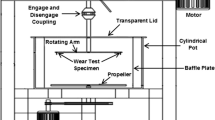Abstract
To clarify the water erosion mechanism of the mild carbon steels, the water erosion experiments were performed by using deionized water as steam source. The results showed that under the damage threshold velocity of liquid impact, the material surface would not be destroyed. However, when the micro-particles were added into the steam, the pits appeared on the surface soon. By comparison, it is found that the pits are quite different from those induced by micro-particles impact without steam, but similar to those induced by cavitation erosion. The results indicated that the water erosion mechanism was similar to that of cavitation erosion under the damage threshold velocity. The micro-particles carry the micro-bubbles to approach the surface of the material, and the micro-bubbles collapse and generate micro-jet to impinge vertically on the surface, which lead to the produce of pits.
Similar content being viewed by others
References
Pollard D, Lord M J, Stockton E C. An evaluation of low pressure steam turbine blade erosion. GECJ Sci Technol, 1983, 1: 29–34
Xing X L, Wang C Z. Analysis to satety of typt — C50 — 8. 83/ 0. 118 steam turbine with humid steam to several end class leafs silce. Coal Technology, 2006, 25: 131–133
Staniša B, Schauperl Z, Grilec K. Erosion behaviour of turbine rotor blades installed in the Krsko nuclear power plant. Wear, 2003, 254: 735–741
RAO J S. Application of fracture mechanics in the failure analysis of a last stage steam turbine blade. Mech Mach Theory, 1998, 33: 599–602
Dehouve J, Nardin P, Zeghmati M. Erosion study of final stage blading of low pressure steam turbines. Appl Surf Sci, 1999, 144–145: 238–243
Yan Y P, Sun B, Cai Y N. The research of water erosion for steam turbine’s rotor blades. Turbin Technol, 1994, 36: 305–317
Lee M K, Kim W W, Chang K R, et al. Investigation of liquid impact erosion for 12Cr steel and Stellite 6B. J Nuclear Mater, 1998, 257: 134–144
Stanisa B, Ivusic V. Erosion behaviour and mechanisms for steam turbine roto blades. Wear, 1992, 186–187: 395–400
Yang B, Ding H, Hu J M. The application of high pressure pulse water jet in simulating liquid impact erosion of materials. PTCA (PART:Physical testing), 2003, 39: 341–345
Kennedy C F, FIELD J E. Damage threshold velocities for liquid impact. J Mater Sci, 2000, 35: 5331–5339
Zhu B T. The effect of solid particle for the water erosion in steam turbine flow passage component and prevention countermeasure. Chin Electric Power, 2003, 36: 150–154
Huang S. The effect of solid particle properties on cavitation erosion in solid-water mixtures. J Fluids Engin, 1996, 118: 749–755.
Chi M P. Investigations of bubble-particle interactions. Int J Miner Process, 2003, 72: 239–254
Li Y J. Study on mechanism of surface topograhpy effects on generation of cavitation erosion. Dissertation for the Doctoral Degree. Beijing: Tsinghua University, 2008.
Marschall H B, Mørch K A, Keller A P, et al. Cavitation inception by almost spherical solid particles in water. Phys Fluids, 2003, 15: 545–553
Mann B S, Vivek A. Coating and surface treatment for enhancing droplet erosion resistance of steam turbine blades. Wear, 2003, 254: 652–667
Tabak W. High-temperature erosion resistance of coatings for use in turbomachinery. Wear, 1995, 186–187: 224–229
Wang L L, Cai X S. progress in research on water droplet size in two phase wet steam flow in steam turbine. J Univer Shanghai Sci Tech, 2003, 25: 307–312
Wang J D, Chen H S, Qin L, et al. The crucial effect of micro-particles in hydraulic machinery cavitation corrosion. Chinese Sci Bull, 2007, 52: 2683–2687
Huan J T. The Principle and Application of Cavitation and Cavitation Erosion. Beijing: Tsinghua University Press, 1991
Klastrup K J, Hansson I, Morch K A. A simple model for cavitation erosion of metals. J Phys D: Appl Phys, 1978, 11: 899–912
Benjamin T B, Ellis A T. The collapse of cavitation bubbles and the pressure thereby produced against solid boundaries. Philos Trans R Soc London Ser A, 1966, 260: 221–240
Author information
Authors and Affiliations
Corresponding author
Additional information
Supported by the Research Fund for the Doctoral Program of Higher Education of China (Grant No. 20070003103), and National Basic Research Program of China (Grant No. 2007CB707702)
About this article
Cite this article
Xu, W., Qin, L., Wang, J. et al. Water erosion mechanism of mild carbon steels induced by micro-particles. Chin. Sci. Bull. 54, 4577–4582 (2009). https://doi.org/10.1007/s11434-009-0589-1
Received:
Accepted:
Published:
Issue Date:
DOI: https://doi.org/10.1007/s11434-009-0589-1




